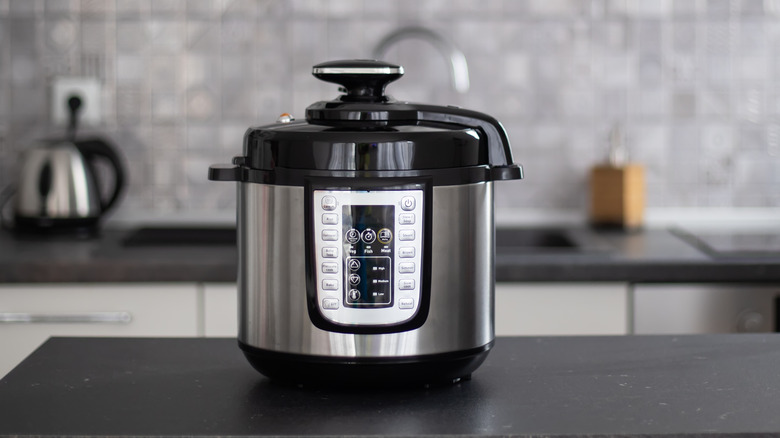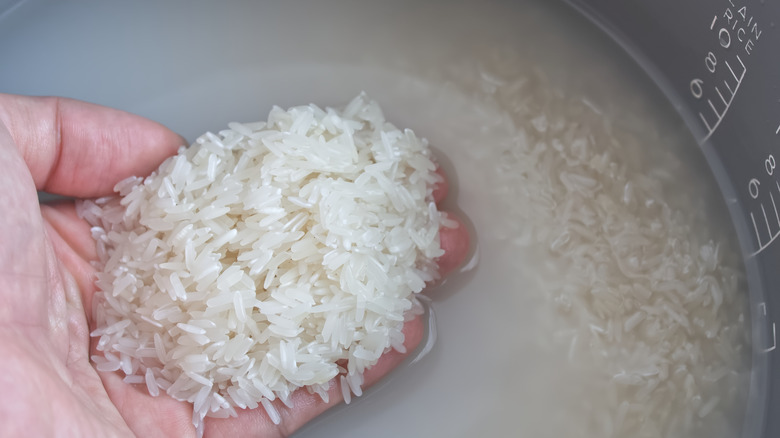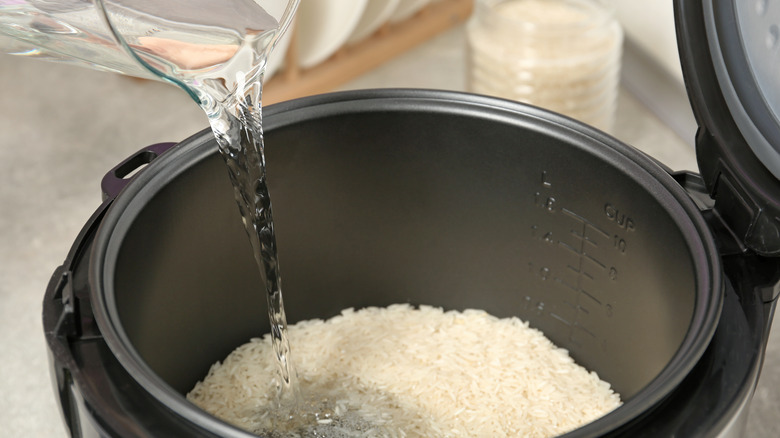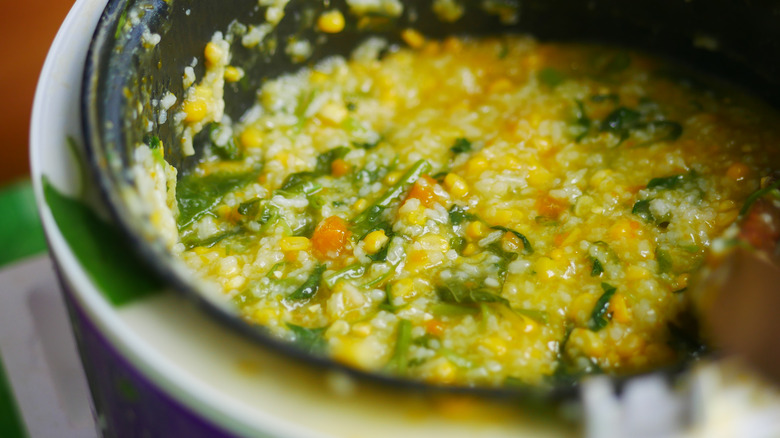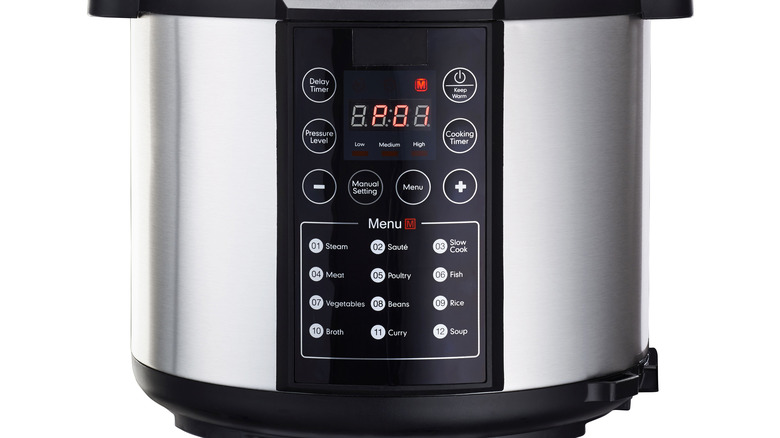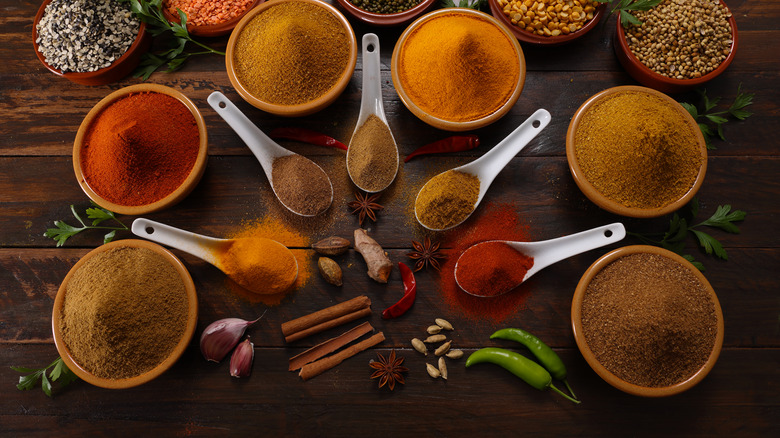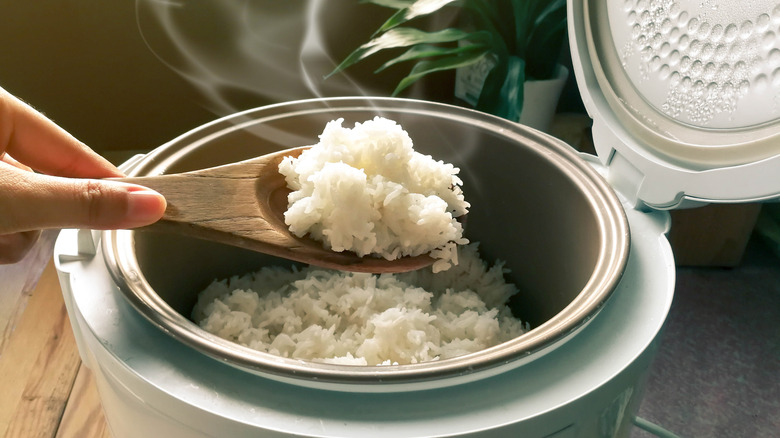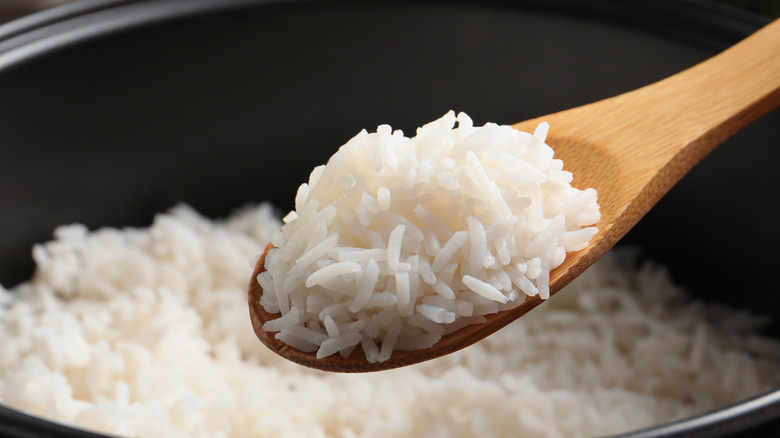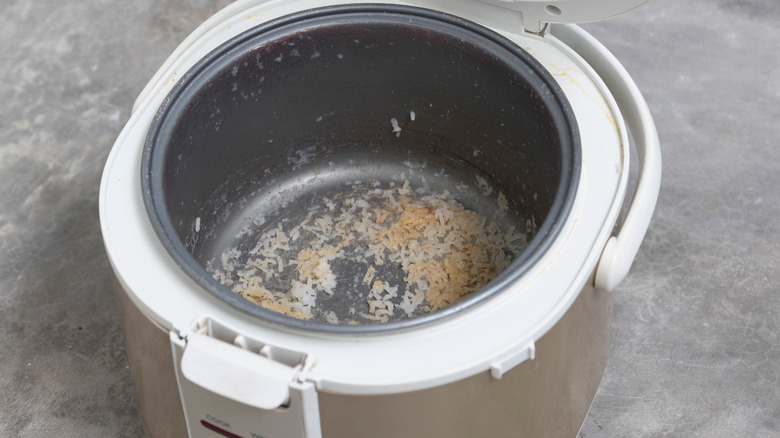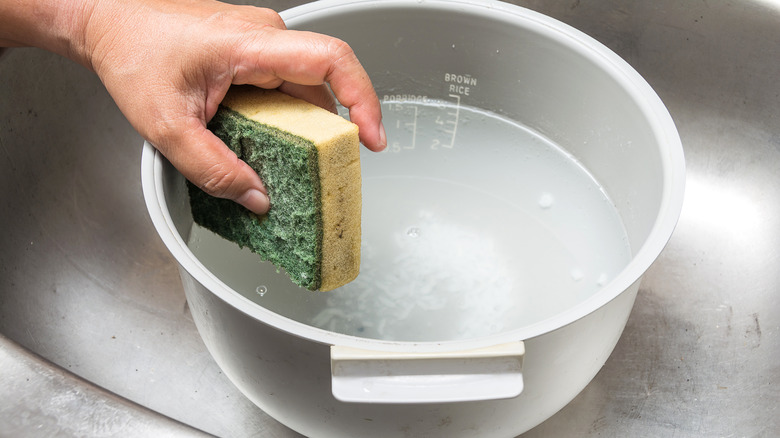Mistakes Everyone Makes With Rice Cookers
While the saucepan method remains a popular choice for cooking rice, an increasing number of individuals are embracing the convenience of electric rice cookers. Not only are rice cookers ultra easy to use, but they also deliver consistent results. Once you measure the rice and water, select the appropriate setting, and press the start button, the rice cooker takes care of the rest. This eliminates the need for constant monitoring and stirring that's often required when using the saucepan method of cooking rice, letting you focus on prepping the other parts of your meal.
Rice cookers are composed of several components, including an electric heating plate, an outer pot, a removable inner pot, and a lid. When you turn on a rice cooker, the built-in electric heating element at the base of the device starts heating the water in the inner pot. As the water heats up, it gradually reaches a boiling point of 212 degrees Fahrenheit. This temperature only starts to rise once the rice absorbs all the water in the inner pot. As soon as this happens, the rice cooker will either automatically switch off or shift to a "keep warm" mode.
While using a rice cooker isn't exactly rocket science, there're a few basic steps that can make the difference between perfectly cooked rice and a mushy or overly crispy mess. Keep reading to learn about the most common mistakes made with rice cookers and how to avoid them.
Not washing the rice
Rinsing rice prior to cooking is essential, and it's not just because unwashed rice can contain impurities, such as dust and debris, which you don't want in your meal. Since rice is coated in starch that breaks down during cooking, not rinsing it before placing it in the rice cooker can result in sticky and mushy grains. On the other hand, removing the starch helps keep the rice kernels separate, resulting in a more appealing texture. Rinsing is crucial for long-grain rice, such as basmati rice and jasmine rice, even short-grain rice, such as Japanese rice, will turn out better if washed prior to the cooking process.
Washing rice is a relatively simple process. For best results, place the rice in a fine-mesh strainer and gently pour cold tap water over it until the water runs clear. This shouldn't take longer than two or three minutes. Never use hot water to wash rice, as this may result in uneven cooking. If you don't happen to have a fine-mesh strainer, you can rinse rice in a regular bowl, saucepan, or even a rice cooker pot. Simply place the rice in the container and submerge it in cold water before swirling the grains around with your hand. Repeat this at least three times or until the water runs clean. Notably, the rinsing rule doesn't apply to nutrient-enriched rice, as washing it is likely to remove those nutrients.
Using the wrong ratio of rice to water
The appropriate water-to-rice ratio is crucial to ensuring that you don't end up with a mushy or crunchy final product. One approach, albeit somewhat imprecise, is the "fingertip measuring method." Simply place the rice in the rice cooker, ensuring that it's level in the pot. Touch the surface of the rice with your index finger and add water until it reaches your first knuckle.
If the fingertip measuring method seems a bit ... well ... sketchy, the measuring cup method might be more your style. While most rice packages should come with cooking instructions, as a rule of thumb, 1 cup of dry, short- or medium-grain white rice requires 1.5 cups of water, as does one cup of dry basmati or jasmine rice. The amount of water goes up to 1.75 cups for long-grain white rice. Meanwhile, 1 cup of dry, long-grain brown rice requires 2.25 cups of water. This being said, it's important to remember that most rice measuring cups that come with rice cookers hold 180 milliliters while standard cups hold 240 milliliters. The best approach is to test your ratio over time before arriving at the perfect mixture that works for you.
Using the rice cooker to only make rice
Despite their name, rice cookers are a great appliance for making a variety of dishes precisely because of the way they operate. Rice cookers work by heating up water to cook ingredients. Once the water hits boiling point, it starts to evaporate, producing steam and cooking the rice. It's precisely this cooking method that makes rice cookers so versatile.
Rice cookers can be used to make a huge variety of dishes, including grains such as oatmeal, quinoa, lentils, and pearl barley. Simply combine the grain with water in the rice cooker and let the machine do its magic while you go about other tasks. Rice cookers can also be used to boil eggs, broths, and soups, as well as steam vegetables and seafood. Some rice cookers even come with a steaming basket or tray, which means that you can prepare your entire meal in just one appliance. Some of the more high-end rice cookers can even be used to make baked goods if you don't have access to an oven.
Not using the rice cooker's settings
Rice cookers are ultra simple to use. All you have to do is fill them with the right amount of ingredients and press the "on" button. Once the food is cooked, the appliance automatically switches to the "keep warm" mode to ensure that it remains at the perfect temperature. However, while they all may appear similar, not all rice cookers are created equal, as evidenced by the variations in their pricing.
At the most basic, rice cookers come with a simple on/off button. However, if you have invested in a smart rice cooker with a range of functions, you may as well put them to good use. Unlike on/off rice cookers, these sophisticated units have the ability to automatically detect the quantities of rice and water and make the appropriate adjustments. They also frequently feature an automatic shut-off function and a timer for scheduling cooking times. Modern rice cookers also usually come with settings for different types of rice, as well as other ingredients such as beans and porridge. Then, there are Instant Pots that combine the functionality of rice cookers, slow cookers, and pressure cookers into one handy appliance.
Not seasoning the rice in the rice cooker
While many of us season our rice after it's been cooked, if you're after a more aromatic grain, it's best to actually season the pantry staple before pressing the "on" button. Beyond the usual salt and pepper, there's a wide array of herbs and spices that can be used to flavor your rice. These include onion powder, chili powder, garlic powder, paprika, cinnamon, nutmeg, ginger, parsley, and cilantro. For golden-colored rice, infuse the water in your rice cooker with a dash of saffron.
Another way of enhancing the flavor of rice involves cooking the grain in chicken or vegetable broth, which can give the rice a heartier flavor when compared with cooking it in just water. Try mixing your water and broth in a 50/50 ratio, as too much broth can ruin the rice's texture. Whatever you do, always make sure that the broth is factored into the rice-to-water ratio.
Opening the rice cooker while it's working
Opening the rice cooker while it's doing its job is a huge no-no. First of all, there's absolutely no need to raise the lid off the cooker to check if the rice is done, since the machine is designed to switch off automatically once the grain is ready. There's also no need to stir rice while it's cooking in a rice cooker. In addition, since rice cookers rely on steam pressure to cook food, opening the appliance while it's working can be downright dangerous, leading to burns.
Lifting the lid of a rice cooker while it's operational can also impact the flavor and texture of the rice. This is because opening the appliance interrupts the cooking process, letting out steam and lowering the temperature inside the device. This, in turn, can lead to overcooked or undercooked rice. Dickson Environmental Monitoring and Compliance Experts conducted a test to determine the temperature variation caused by raising the lid of a rice pot. The company found that lifting the lid of a rice cooker decreased the temperature inside the pot by around 96 degrees Fahrenheit. It took around 30 seconds for the rice cooker to return to its previous temperature after the lid was replaced.
Not letting the rice rest after cooking
While it's tempting to dig into your rice right after the cooker dings to let you know that your food is ready, a little patience can go a long way. Letting the rice sit for five to ten minutes after the device has finished its cycle allows the grains to soak up any residual moisture, preventing any sogginess.
This short resting time can make a substantial difference in the texture and flavor of the rice. It helps the rice grains become firmer and makes them less likely to become overly sticky and fuse together. Once the rice has had its steaming time, you can use a fork or rice paddle to gently fluff the grains. This helps to aerate and separate the kernels, improving their overall texture. Fluffing the rice also makes it more visually appealing, as the individual grains stand out and don't turn into a congealed mass.
Keeping the rice in the rice cooker for too long
Once the cooking process is complete, most rice cookers will automatically switch to a "keep warm" function to hold the food at an ideal serving temperature. While the internal temperature of a rice cooker reaches 212 Fahrenheit during cooking, it drops to 140 Fahrenheit in the "keep warm" mode, the minimum required by the USFDA to keep food safe for consumption for longer than two hours. Even though rice stored at the "keep warm" setting may remain safe to eat for up to 24 hours, it's best to eat it within five hours of cooking.
Further, the rice will only actually stay at 140 degrees if the temperature inside the cooker doesn't fall below this threshold. Frequent opening of the appliance to take the rice out, however, is likely to cause a drop in temperature, accelerating deterioration. This is particularly significant because even cooked rice can harbor the spores of Bacillus cereus, a bacteria that can cause food poisoning (from NHS). Keeping the rice warm for too long can give these spores time to develop and cause digestive issues.
Aside from making you sick, rice that has been in a rice cooker for too long will lose flavor and texture. In fact, rice starts to deteriorate just two hours after cooking. If you leave the rice on the "keep warm" setting for long enough, it will dry out and turn yellow.
Not taking the time to clean the rice cooker after use
While there are many different opinions about how frequently a rice cooker should be cleaned, we recommend cleaning the appliance thoroughly after each use. Doing this will ensure the removal of any leftover bits of food and prevent the growth of bacteria. It will also prolong the rice cooker's lifespan by preventing the accumulation of burnt-on food that could potentially damage the device.
To clean your rice cooker, unplug it, let it cool down, and disassemble any removable parts, including the inner pot, any utensils such as a steamer tray, and the lid (if it's detachable). Handwash these components with a little detergent or pop them in the dishwasher after confirming that they are dishwasher-safe. Be sure to dry all the parts with a towel before reassembling and storing the unit. While this isn't as important, you can also wipe the exterior of the rice cooker with a damp cloth to keep it free from any residue or dust.
